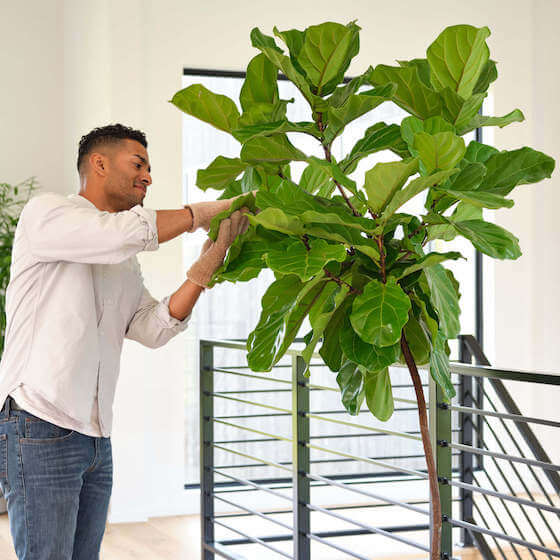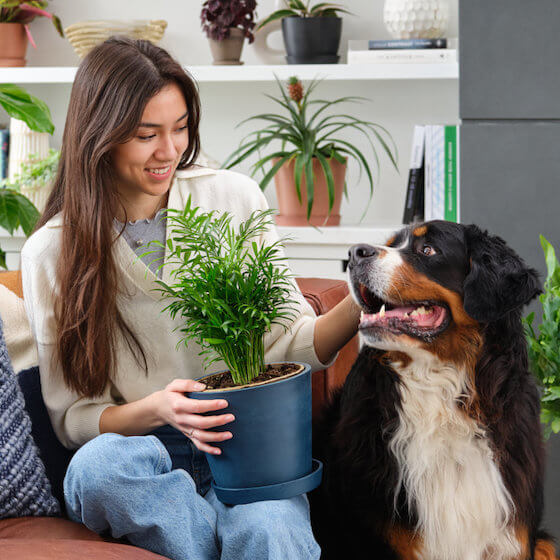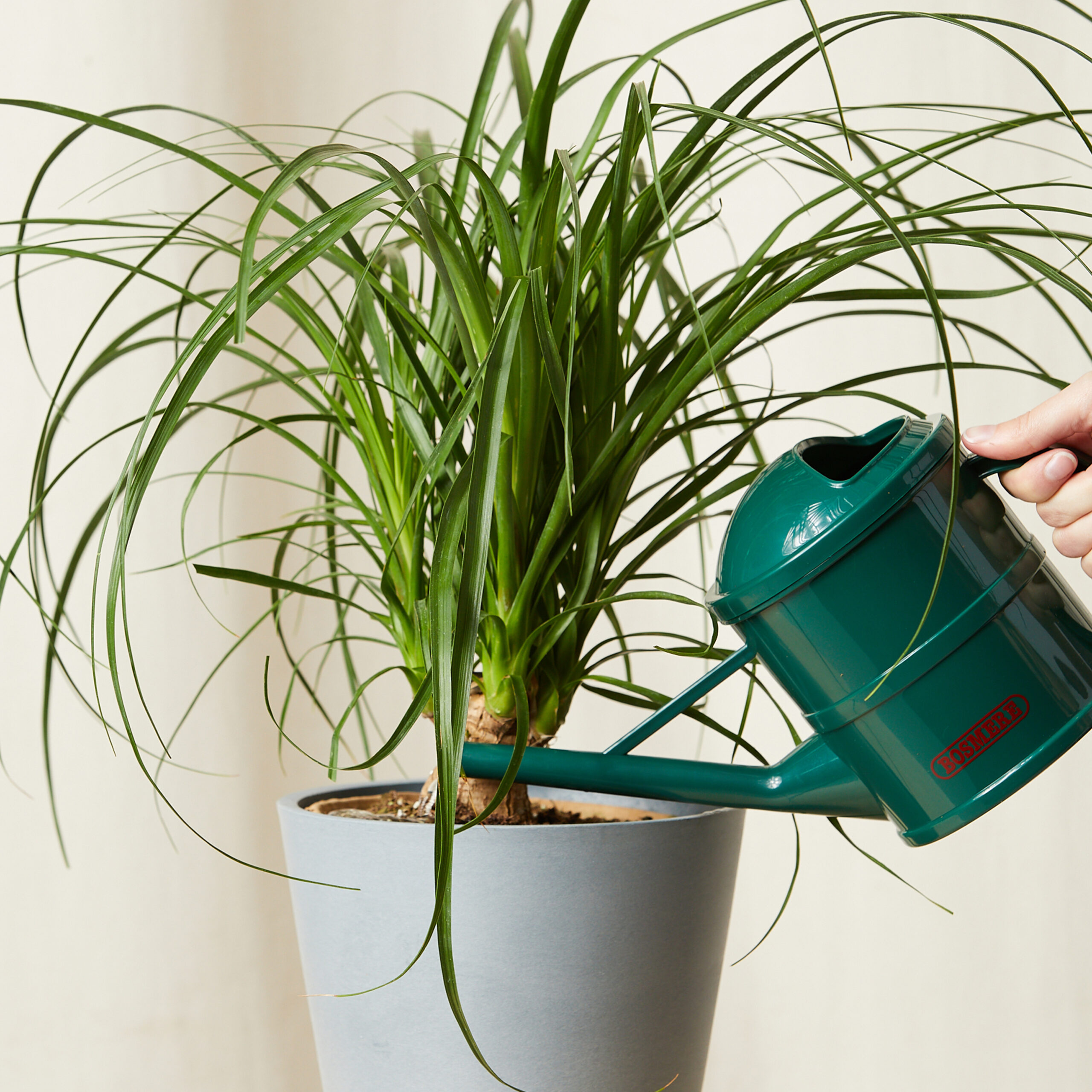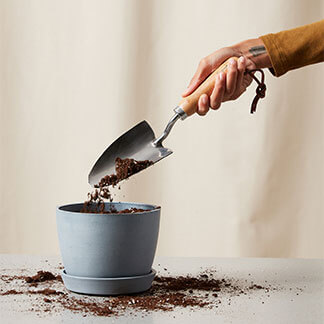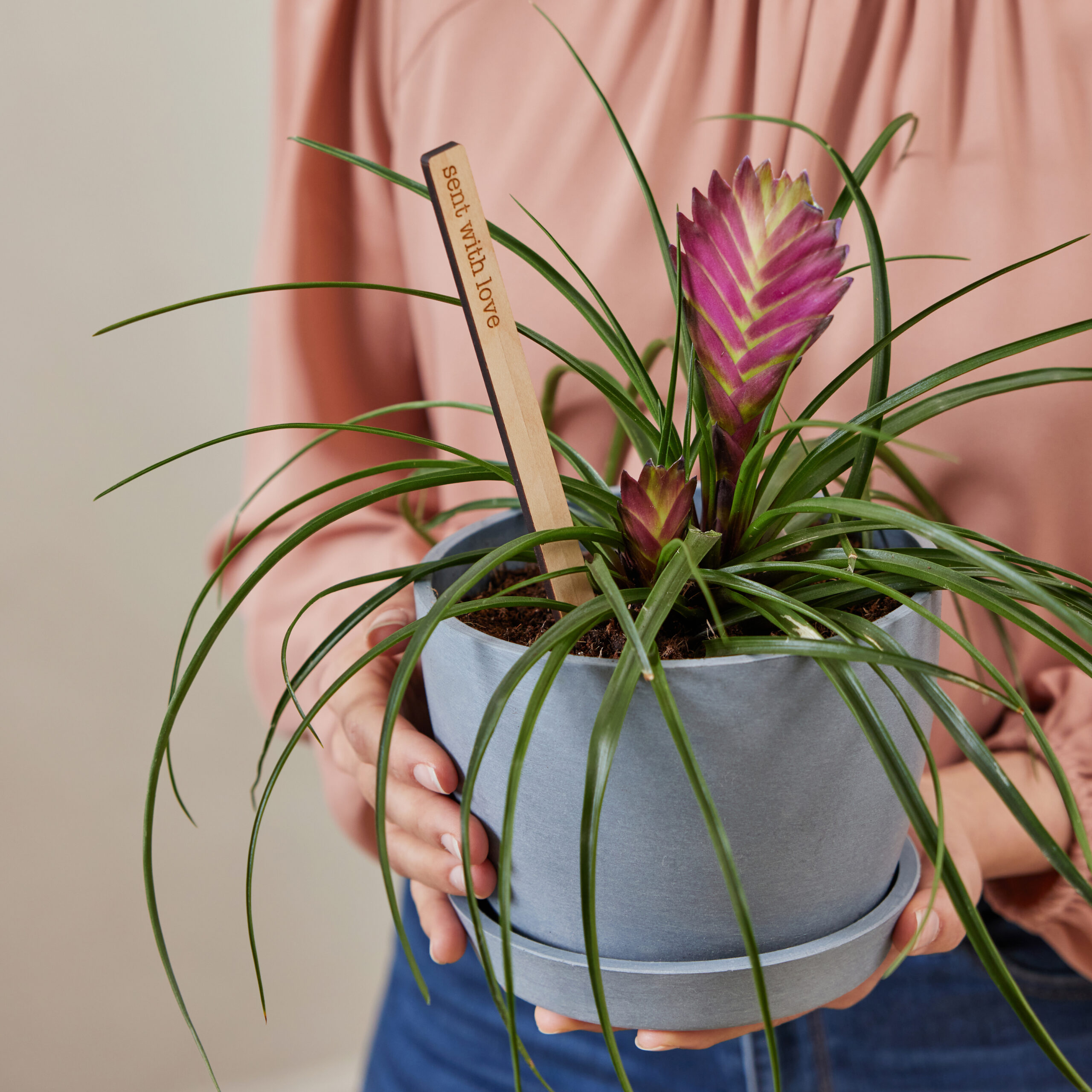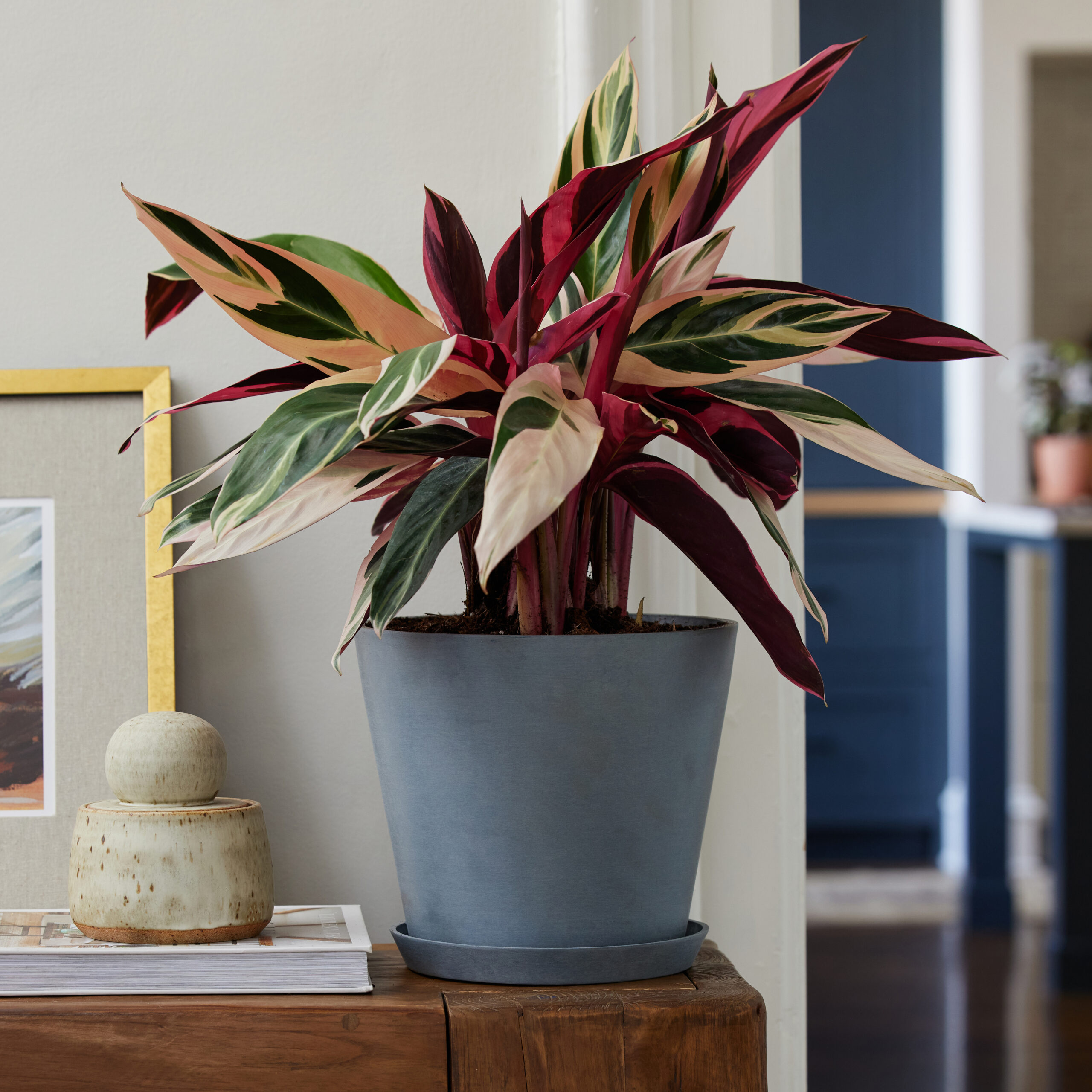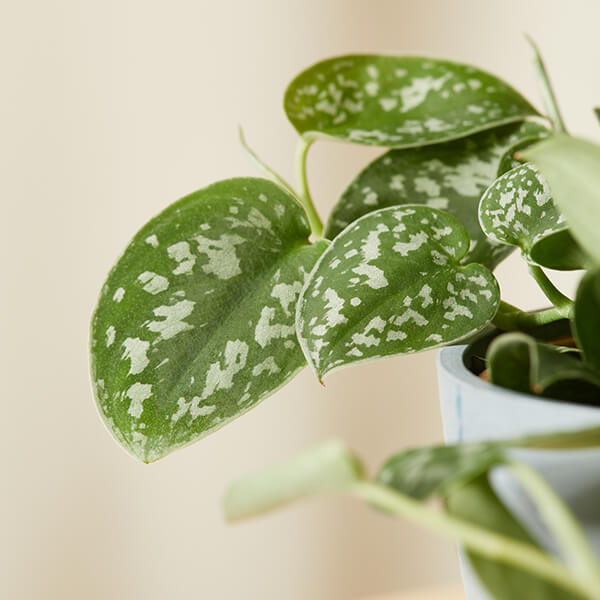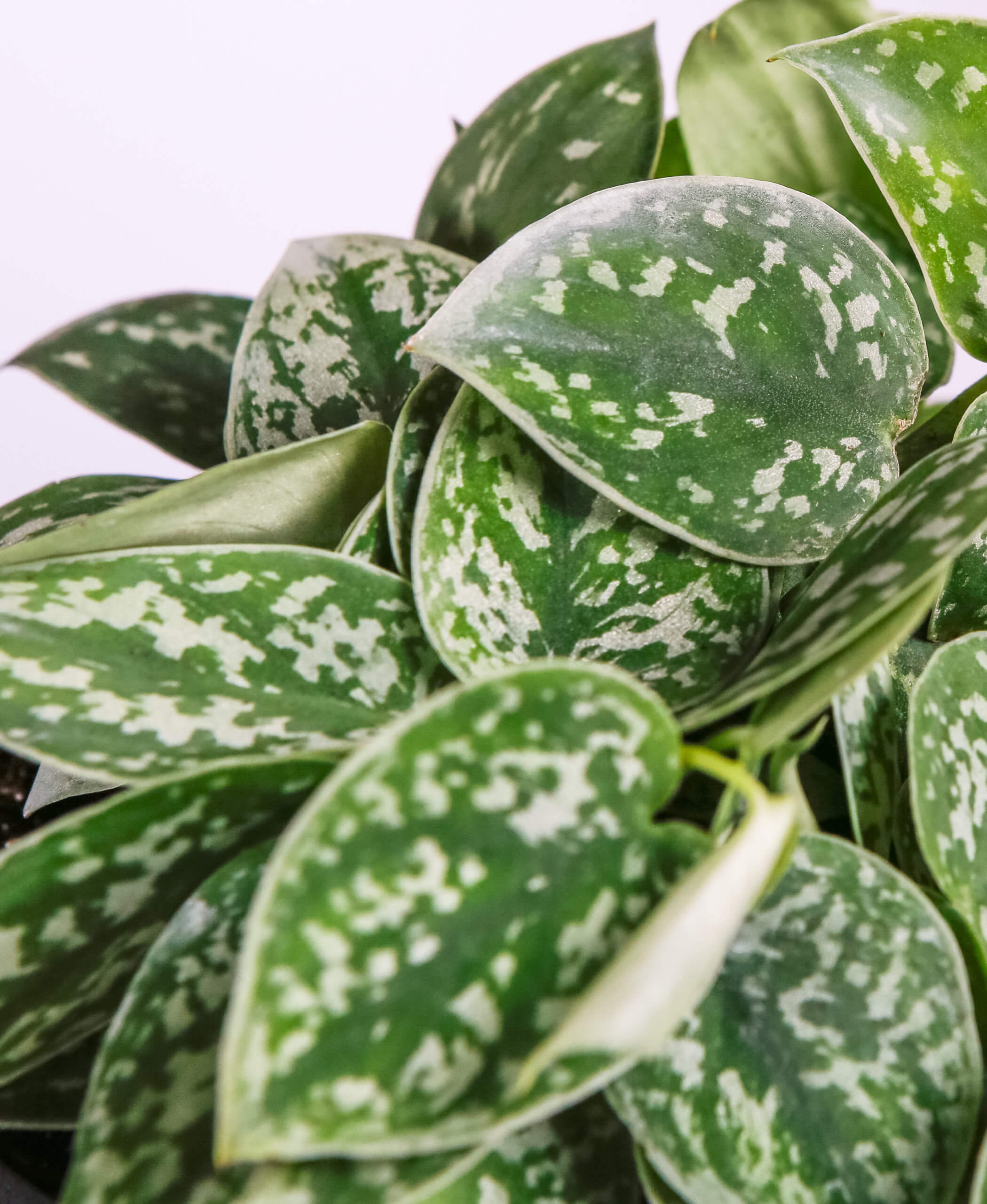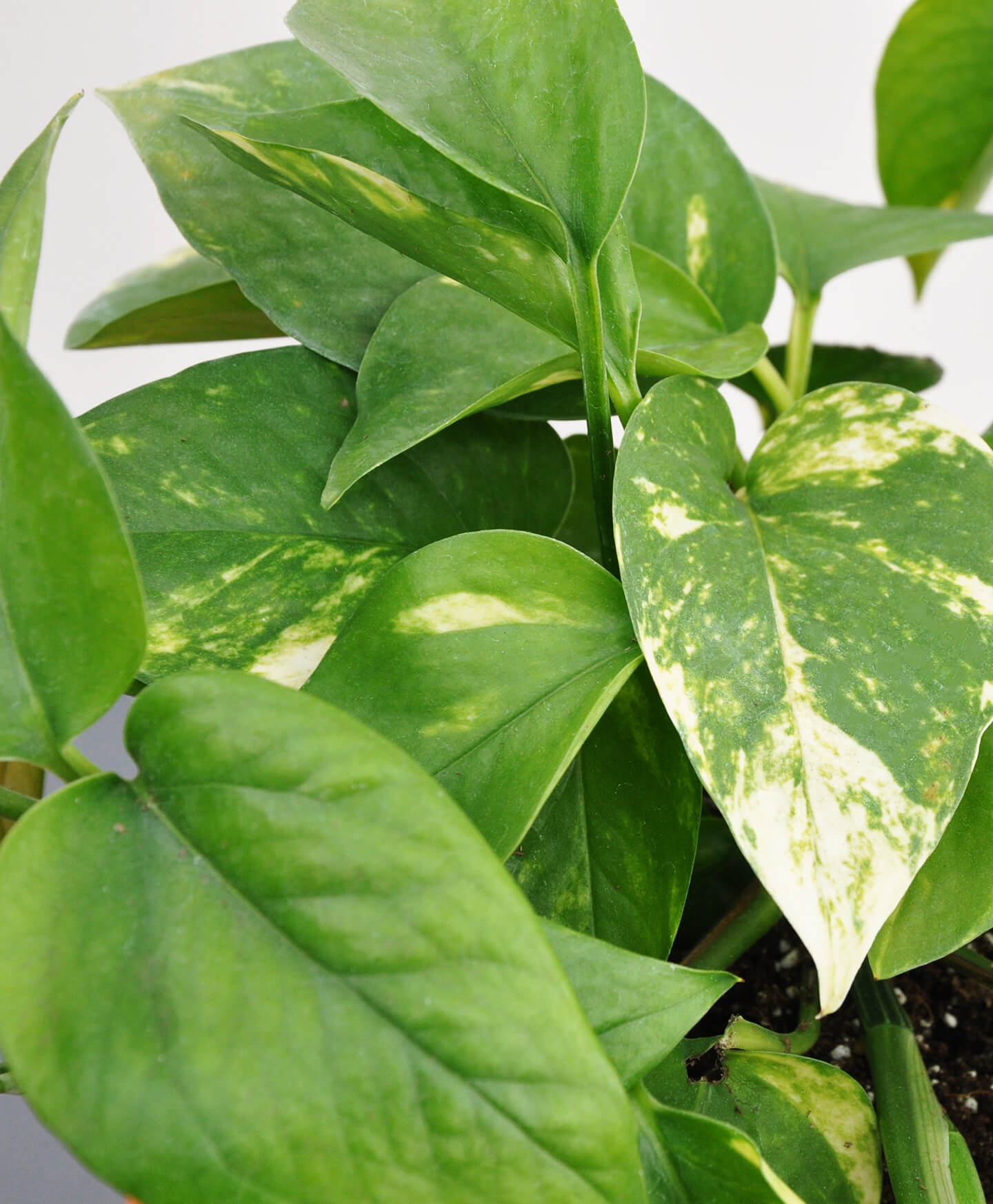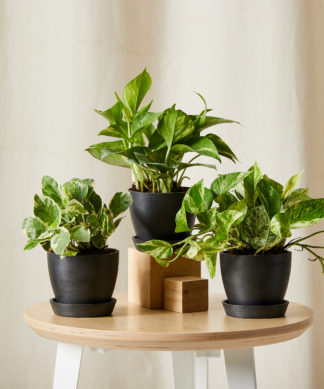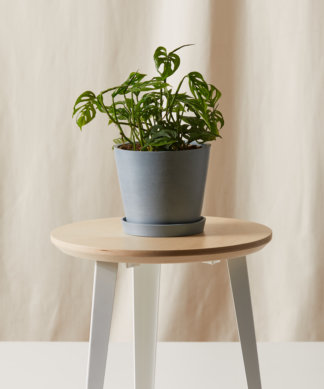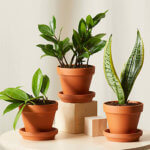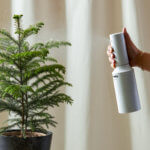How to care for your Pothos
Use these instructions to care for a Pothos. This guide will tell you how to water a Pothos; its light, temperature, humidity preferences and any additional care it might need to help it grow.
Baltic Blue Pothos
Your Pothos prefers indirect bright light. It can tolerate lower light, but growth will slow. Avoid prolonged exposure to direct light, which can scorch the leaves.
Water your Pothos when 50-75% of the soil volume is dry. Water until liquid flows through the drainage hole at the bottom of the pot and discard any water that has accumulated in the saucer.
Your Pothos will do well in average household humidity, but will thrive with a boost of humidity. Try adding a pebble tray, grouping with other plants, or placing a humidifier nearby.
Your Pothos prefers temperatures between 65-85°F.
Feed once per month in spring through fall with an all-purpose fertilizer for indoor plants, diluted to half strength. Never apply fertilizer to dry soil.
This plant is considered toxic to pets and humans if ingested.
Trim out any dead, discolored, or damaged leaves and stems as they occur with clean, sharp scissors. Snipping stems just above a leaf node will encourage bushy and fuller growth. Stems that are removed can be easily propagated in water.
Cebu Blue Pothos
Your Cebu Blue Pothos can survive in low light, but grows faster in medium to bright indirect light. Direct sunlight can burn the foliage.
Water your Pothos when the top 50-75% of the soil is dry. Water until liquid flows through the drainage hole at the bottom of the pot and discard any water that has accumulated in the saucer. These plants can tolerate an occasional missed watering.
Your Pothos will do well in low humidity environments, but will thrive with a bit more humidity.
Your Cebu Blue Pothos prefers average to warm temperatures between 65-85°F.
Feed every 1-2 months in the spring and summer with general-purpose indoor plant fertilizer. Before applying fertilizer in any form make sure the soil is damp.
Pothos are mildly toxic to pets and humans. Typically, ingestion will cause mouth and stomach irritation and possible vomiting.
Trim any dead, discolored, damaged, or diseased leaves and stems as they occur. Use clean, sharp scissors to avoid tearing or bruising the stems. If you wish to keep your plant full and bushy, trim the longer vines every few months.
Golden Pothos
Your Pothos prefers indirect bright light. It can tolerate lower light, but growth will slow and the colors may fade. Direct light can scorch the leaves.
Water when 50-75% of the soil volume is dry. Water until liquid flows through the drainage hole at the bottom of the pot and discard any water that has accumulated in the saucer.
This plant does well in average household humidity but appreciates an occasional boost of humidity. Try adding a pebble tray, grouping it with other plants, or placing a humidifier nearby.
Your plant prefers temperatures between 65°-85°F. Avoid cold drafty areas and open vents.
Feed once a month in the spring and summer with general-purpose houseplant fertilizer diluted to half-strength. Never apply fertilizer to dry soil.
Your Pothos is considered toxic to humans and pets if ingested.
Trim out any dead, discolored, or damaged leaves and stems as they occur with clean, sharp scissors. Snipping stems just above a leaf node will encourage bushy and fuller growth. Stems that are removed can be easily propagated in water.
Hawaiian Pothos
Your Pothos is adaptable. It prefers bright, indirect light, but will tolerate medium and low light. The variegation will be more pronounced in brighter light. Your Pothos will not do well in direct sunlight–the sunlight can burn the foliage.
Water your Pothos when the top 50% of the soil is dry. Water until liquid flows through the drainage hole at the bottom of the pot and discard any water that has accumulated in the saucer. Look out for yellow leaves, they are a symptom of too much water.
This plant will do well in environments with low humidity but will thrive in a location that is more humid, such as a bathroom or kitchen. Brown leaf tips may indicate the air is too dry.
Your Hawaiian Pothos prefers average to warm temperatures of 65-85 degrees.
Feed monthly or every other month in the spring and summer with a general-purpose indoor plant fertilizer. Before applying any fertilizer in any form make sure the soil is damp.
Pothos are mildly toxic to pets and humans. Typically, ingestion will cause mouth and stomach irritation and possible vomiting.
Trim any dead, discolored, damaged, or diseased leaves and stems as they occur. Use clean, sharp scissors to avoid tearing or bruising the stems. Snip stems just above a leaf node; new growth will emerge from this cut.
Jade Pothos
Your Jade Pothos is able to adapt to lower light but thrives in bright, indirect light year-round. Harsh, direct sunlight will scorch the leaves, while not enough light will cause the leaves to become discolored and smaller in size.
Water your Pothos when the top 50% of the soil is dry. Water until liquid flows through the drainage hole at the bottom of the pot and discard any water that has accumulated in the saucer.
Your Jade Pothos does best in a slightly more humid environment, such as a bathroom or kitchen. Brown leaf tips may indicate the air is too dry.
Your Jade Pothos prefer temperatures of 65-85 degrees.
Feed monthly or every other month in the spring and summer with a general-purpose indoor plant fertilizer. Before applying any fertilizer in any form make sure the soil is damp.
Your Jade Pothos is mildly toxic to pets and humans. Typically, ingestion will cause mouth and stomach irritation and possible vomiting.
Feel free to trim your Jade Pothos regularly. Trim any dead, discolored, damaged, or diseased leaves and stems as they occur. Use clean, sharp scissors to avoid tearing or bruising the stems. Snip stems just above a leaf node; new growth will emerge from this cut.
Marble Queen Pothos
Your Pothos prefers indirect bright light. It can tolerate lower light, but growth will slow and the colors may fade. Direct light can scorch the leaves.
Water when 50-75% of the soil volume is dry. Water until liquid flows through the drainage hole at the bottom of the pot and discard any water that has accumulated in the saucer.
This plant does well in average household humidity but appreciates an occasional boost of humidity. Try adding a pebble tray, grouping it with other plants, or placing a humidifier nearby.
Your plant prefers temperatures between 65°-85°F. Avoid cold drafty areas and open vents.
Feed once a month in the spring and summer with general-purpose houseplant fertilizer diluted to half-strength. Never apply fertilizer to dry soil.
Your Pothos is considered toxic to humans and pets if ingested.
Trim out any dead, discolored, or damaged leaves and stems as they occur with clean, sharp scissors. Snipping stems just above a leaf node will encourage bushy and fuller growth. Stems that are removed can be easily propagated in water.
Neon Pothos
Neon Pothos is able to adapt to lower light but thrives in bright, indirect light year-round. Harsh, direct sunlight will scorch the leaves, while too little light will cause the leaves to become a pale green and smaller in size.
Water your Pothos when the top 50% of the soil is dry. Water until liquid flows through the drainage hole at the bottom of the pot and discard any water that has accumulated in the saucer. Look out for drooping yellow leaves, they are a symptom of too much water.
Your bathroom or kitchen would be a great choice for your Neon Pothos because it does best in a slightly more humid environment. Brown leaf tips may indicate the air is too dry.
Neon Pothos prefer average to warm temperatures of 65-85 degrees during the day and not below 60 degrees at night.
Feed monthly or every other month in the spring and summer with a general-purpose indoor plant fertilizer. Before applying any fertilizer in any form make sure the soil is damp prior to application.
Your Pothos is mildly toxic to pets and humans. Typically, ingestion will cause mouth and stomach irritation and possible vomiting.
Feel free to trim your Neon Pothos regularly. This encourages the plant to develop more side-shoots and reduces the demand for the plant to develop a larger root system while in a confined container.
Pearls and Jade Pothos
Your Pothos prefers indirect bright light. It can tolerate lower light, but growth will slow and the colors may fade. Direct light can scorch the leaves.
Water when 50-75% of the soil volume is dry. Water until liquid flows through the drainage hole at the bottom of the pot and discard any water that has accumulated in the saucer.
This plant does well in average household humidity but appreciates an occasional boost of humidity. Try adding a pebble tray, grouping it with other plants, or placing a humidifier nearby.
Your plant prefers temperatures between 65°-85°F. Avoid cold drafty areas and open vents.
Feed once a month in the spring and summer with general-purpose houseplant fertilizer diluted to half-strength. Never apply fertilizer to dry soil.
Your Pothos is considered toxic to humans and pets if ingested.
Trim out any dead, discolored, or damaged leaves and stems as they occur with clean, sharp scissors. Snipping stems just above a leaf node will encourage bushy and fuller growth. Stems that are removed can be easily propagated in water.
Pearls N Joy Pothos
Your Pearls N Joy Pothos grows best in medium and high light areas but will tolerate low light. The variegation will be more pronounced in higher light. Direct sunlight will burn the foliage.
Water your Pothos when the top 75% of soil is dry. Don’t worry if you forget—it will tolerate an occasional missed watering! Look out for yellow leaves, they are a symptom of too much water.
This plant will do well in low humidity environments but will thrive with a bit more humidity. Mist often. Brown leaf tips may indicate the air is too dry.
Your Pearls N Joy Pothos prefers average to warm temperatures, 65-85 degrees.
Fertilize once a month with an all-purpose fertilizer for houseplants.
Your Pothos is mildly toxic to pets and humans. Typically, ingestion will cause mouth and stomach irritation and possible vomiting.
Trim out any dead, discolored, damaged, or diseased leaves and stems as they occur. Use clean, sharp scissors to avoid tearing or bruising the stems. Snip stems just above a leaf node – new growth will emerge from this cut.
Silver Satin Pothos
Keep your Pothos Plant in indirect bright light. Too little light will cause the silver color to fade, but too much light will burn the leaves. If you place your plant near a window where the sun shines directly, covering it with a translucent curtain or shade will protect the leaves from getting scorched.
While your Pothos may like regular drinks of room-temperature water, you’ll need to avoid overwatering. These plants like to be mostly dry between waterings due to their thick leaves. Water only when the top two inches of the soil volume are dry until you see the excess liquid draining from the bottom of the pot.
Your Pothos Plant does well in environments with 40% to 50% humidity. However, if you need to ramp up the moisture in the air, use a humidifier or a pebble tray. Misting is not recommended because this can cause rotting since the aerial roots would absorb the water.
Pothos Plants thrive in average to warm temperatures of 65-85°F. Thus, you’ll need to avoid placing your plant near cold drafty areas and open vents,especially if your heater is running in the winter. Likewise, your Pothos doesn’t like cold temperatures, as this can cause damage.
Your Pothos would grow best if fed on a monthly basis from spring until fall which are the prime growing seasons. A water-soluble formula that’s diluted provides the best nutrition for your plant.
The SIlver Satin Pothos is toxic to humans and pets if ingested.
Trim out any dead, discolored, damaged, or diseased leaves and stems as they occur with clean, sharp scissors. Snip stems just above a leaf node; new growth will emerge from this cut and trimming close to the node will also prevent an ugly stub at the site. Use sharp pruning shears to avoid tearing the stems.
